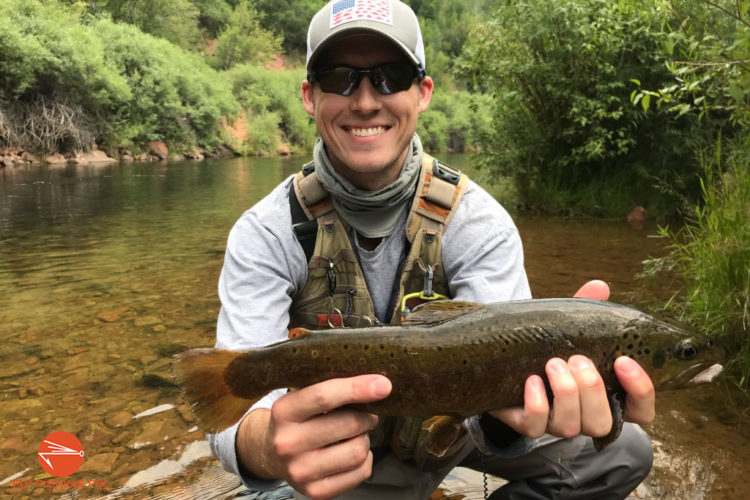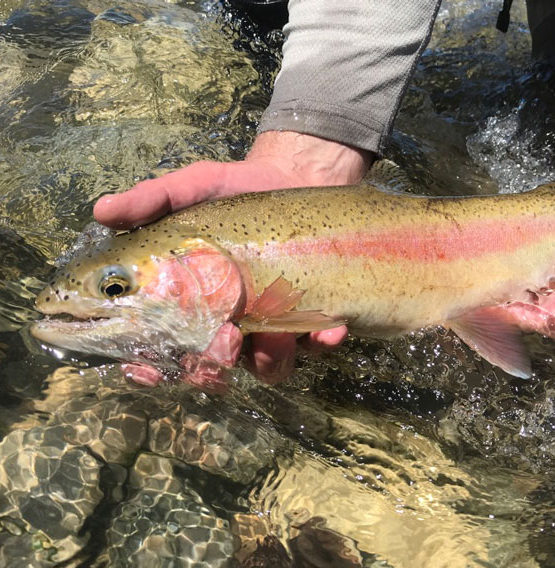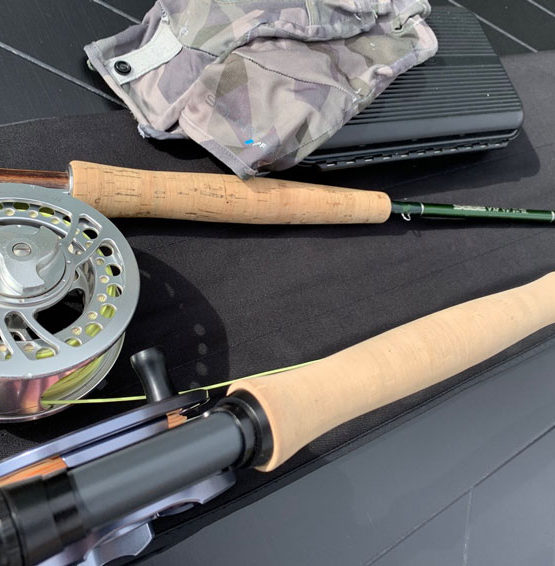Nymphing shallow water is something every angler should learn to do. And while, at first glance, it might not seem that different from nymphing deeper water, if you try to fish it the same way, you are in for a disappointing surprise.
With that in mind, in this article, I’m going to share a few shallow water nymphing tips and techniques you can employ to seriously increase your fish-catching odds.
Let’s get right to it!
Disclaimer: This post may contain affiliate links, meaning we will receive a small commission (at no cost to you) if you click through and make a purchase.1. Use Heavy Nymphs Instead Of Weights
When you are nymphing shallow water, you should remove your weights and fish with heavier, beadhead nymphs. Fly patterns that incorporate a bead head sink fast enough to get to the bottom quickly. And without the added splash of weights when your rig hits the surface of the water, you will be less likely to disturb or spook the fish.
Additionally, if you really want to get your flies to the bottom quickly, you should try to fish with fly patterns that incorporate other heavy materials like colored or lead wire.
A few of my favorite heavy nymph patterns include the Copper John, Beadhead Prince Nymph, Beadhead Flashback Pheasant Tail, and just about any Beadhead Stonefly Nymph.
Related Posts:
- 10 Baetis Nymph Patterns You Need To Try
- 9 Killer Nymphing Tips For Beginners
- Fly Fishing With Small Flies (The Complete Guide)
2. Forget The Indicator, Try Sight-Casting
If you’ve never tried nymphing shallow water without an indicator, then now is the time. Like nymphing without weights, when you remove your indicator, it reduces your likelihood of spooking the fish. And in shallow water, that’s pretty much the name of the game.
Beyond that though, in shallow water, most of the time you can actually see the fish. And when that’s the case, you will actually have a better chance of catching them by sight-casting, which doesn’t require an indicator.
For those of you that have never tried sight-casting, or are unsure what it is, allow me to provide you with a brief overview.
Sight-casting is a nymphing technique where you watch the fish rather than your indicator. Instead of casting far upriver, and allowing your rig to drift as long as possible, you cast a few feet in front of the specific fish you are trying to catch, and watch for signs of a take. Typically, you will be looking for the fish to make a subtle move to one side or the other, but sometimes, the fish will flash it’s side, or even jump clear out of the water.
Sight-casting is a phenomenal technique for nymphing shallow water. So, lose the indicator, and give it a try.
3. Try A Dry Dropper Rig
While the dry dropper rig isn’t purely nymphing, it is a great technique for catching fish in shallow water. You see, with a dry dropper rig, you get the benefit of fishing both a dry fly and a nymph, but also, your dry fly acts as an indicator.
Using a dry dropper rig is particularly great for fishing small streams and creeks with pocket water, and cutbanks. However, it will work in just about every shallow water fly fishing situation.
For more on how to set up and fish a dry dropper rig, be sure to read our related article: How To Tie A Dry Dropper Rig (5 Simple Steps).
4. Look For Structure
When you are nymphing shallow water, you should focus your casting efforts near any kind of structure. For example, if you see a boulder in the middle of a river, try casting into the soft water directly behind it. If you ever see a bush, tree or log protruding into the water from the bank, carefully throw a couple casts around it.
Fish are both good at conserving energy and fearful. So, if you see any kind of structure that could either shield them from swift current, or protect them from predators, be sure to throw a couple casts around it. That’s where fish tend to stack-up.
Related Posts:
5. Pay Attention To Your Shadow
In shallow water, fish tend to be extra skittish. And if you don’t pay attention to your shadow, and allow it to cast over the water, they might mistake you for an aerial predator and swim for cover. As an angler, that doesn’t bode well for your fish count.
One wrong move with your shadow, and you could spook an entire school of feeding fish.
So, whenever you are nymphing shallow water, be acutely aware of your shadow, and avoid casting it over the water. At times, you will have to cross a river further downstream so that you can approach a hole from the opposite bank. Other times, you will need to cast in a crouched position, or on your knees.
The more you avoid casting a shadow on the water, the better chance you have of catching fish.
Related Post: 21 Common Fly Fishing Mistakes To Avoid
6. Use Sturdy Flies
One thing about nymphing shallow water is that your flies are going to take more abuse than they would in deep water. Think about it, in most cases, if your flies are drifting down a shallow stream they are probably going to be ramming into rocks your entire drift.
With that in mind, you should try to select fly patterns that hold up to these rough conditions. For instance, flies with epoxy, colored wire, and beadheads, tend to hold up well in shallow water.
Related Post: How To Tie A Double Nymph Rig? A Step-By-Step Guide
7. Keep Your Flies Clean
Another thing about nymphing shallow water is that your flies are more likely to get gunked-up (that’s a technical fly fishing term) with mud, algae and other plant life. And one thing I know for sure, is that fish are smart enough to avoid flies like that.
Therefore, you should get in the routine of checking and cleaning your flies every few casts.
Beyond just cleaning off mud and algae, you should check your flies for any loose threads or hackle fibers that need to be trimmed. I can’t tell you how many times I have trimmed or cleaned-up my flies and caught a fish on the very next cast.
In fly fishing, presentation is everything. So, if you want to catch more fish, be sure to keep your flies clean.
8. Add A Little Flash
If you’re ever nymphing shallow water and you just can’t seem to get the fish interested, try throwing on an attractor nymph. I’ll be honest, I’m not sure why fish seem to react well to flashy flies in shallow water, but I can tell you from experience that they do.
If you’re looking for a few flashy nymph patterns to try, I recommend the Rainbow Warrior, Sparkle Wing RS2, and the Flashback WD-40.
9. Be Quiet
I’ve already made mention of this a time or two in this article, but fish in shallow water tend to spook easily. So, if you are thrashing the water while you wade, or yelling to your buddies that are fishing way upriver, then you are hurting your chances of catching a fish.
Just be quiet. You’ll catch more fish.
10. Use Lighter Tippet And Leader
In shallow water, fish have an easier time seeing your leader and tippet. So, in just about every case, you should opt for lighter tippet and leader. In general, I recommend fishing with 5X or smaller. Sure, you might risk losing a few more fish, but that’s better than never hooking a fish at all.
Related Posts:
- Do You Need Tippet For Fly Fishing?
- How Long Does Tippet Last? (Plus 5 Tips To Make It Last Longer)
- How Often Should You Clean Your Fly Line?
Nymphing Shallow Water: Bottom Line
In this post we covered 10 simple tips you can use when nymphing shallow water. Between fishing with heavy nymphs, sight-casting without an indicator, keeping your flies clean, and using lighter tippet, I hope these tactics will help you catch more fish.
In the meantime, are there any other tactics that you use when nymphing shallow water? Leave your comments below.
Also, if you enjoyed this article, and want to get our posts, tips and recommendations sent directly to your inbox, be sure to subscribe to Fly Fishing Fix!











Zach, Loved the article. I’ve curious about not using a stick indicator – Along with this would you also recommend using a Nymphing fly line? Also having used the same heavier bead headed Nymphs would you also recommend a heaver rod and weighted line? Say a 6 or 7?
Hi Gary,
Thanks for the comment! You certainly can use nymphing fly line, but I don’t tend to get that technical with my gear when I’m on the water. That said, if you are going to be doing a ton of nymphing with lots of weight, and heavy flies, I definitely recommend setting yourself up with a 6-weight. If you’re looking for a good option, I personally recommend the Orvis Recon. It has a nice punch in windy conditions, and handles heavy rigs without any problem.
Gary
Thank you for sharing your nymphing knowledge with us neophytes out here in stream land! I need all the help I can get.